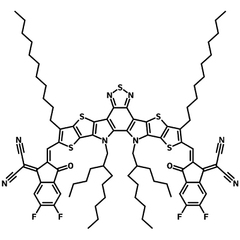BTP-4F-12, Y6-BO (Y12)
CAS Number 2389125-23-7
Green Energy Materials, Non-Fullerene Acceptors, Organic Conductors
BTP-4F-12, great for solution processability and mass device production
Low price, high purity (>98%) BTP-4F-12 available in sensible quantities
BTP-4F-12 (CAS number 2389125-23-7), also known as Y12, is a family member of BTP-4F (Y6). The two materials are very similar with the only difference between Y12 and Y6 being that Y12 has two butyloctyl side chains to the [1,2,5]thiadiazolo[3,4-e]thieno[2",3’':4’,5']thieno[2',3':4,5]pyrrolo[3,2-g]thieno[2',3':4,5]thieno[3,2-b]indole core while Y6 bears two ethylhexyl chains.
Comparing to Y6, Y12 has greater solubility and for this reason, Y12 has great advantage for solution processability and mass device production with environmentally benign solvents as active layer materials for organic polymer solar cells.
High efficient non-flullerene acceptor
With highly conjugated core
Enhanced solubility
with butyloctyl alkyl chains
Worldwide shipping
Quick and reliable shipping
Green energy materials
Processable in non-halogenated solvents
While PM6 (PBDB-T-2F) was used as the low band-gap donor polymer, mixed two well-compatible non-fullerene acceptors BTP-4F-12 and MeIC showed a great device performance with 17.4% efficiency and a high open-circuit voltage of 0.863 with minimum energy loss.
Device structure: ITO/PEDOT:PSS/PM6:BTP-4F-12:MeIC/PDIN/Al. [1]
| Thickness (nm) | VOC (V) | JSC (mA cm-2) | FF (%) | PCE (%) |
|---|---|---|---|---|
| N/A | 0.863 | 25.4 | 79.2 | 17.4 |
General Information
| CAS Number | 2389125-23-7 |
|---|---|
| Chemical Formula | C90H102F4N8O2S5 |
| Purity | >98% (1HNMR) |
| Full Name | 2,2'-((2Z,2'Z)-((12,13-bis(2-butyloctyl)-3,9-diundecyl-12,13-dihydro-[1,2,5]thiadiazolo[3,4-e]thieno[2",3":4',5']thieno[2',3':4,5]pyrrolo[3,2-g]thieno[2',3':4,5]thieno[3,2-b]indole-2,10-diyl)bis(methanylylidene))bis(5,6-difluoro-3-oxo-2,3-dihydro-1H-indene-2,1-diylidene))dimalononitrile |
| Molecular Weight | 1564.18 g/mol |
| Absorption | λmax 715 nm (Film) |
| HOMO / LUMO | HOMO = -5.68 eV, LUMO = -4.06 eV [1] |
| Solubility | Chloroform, chlorobenzene |
| Form | Dark blue powder/crystals |
| Synonyms | Y6-BO, BTP-BO-4F, Y12 |
| Classification / Family | NFAs, n-type non-fullerene electron acceptors, Organic semiconducting materials, Low band-gap small molecule, Small molecular acceptor, Organic photovoltaics, Polymer solar cells, NF-PSCs. |
Chemical Structure

MSDS Documentation
Pricing
| Batch | Quantity | Price |
|---|---|---|
| M2245A1 | 50 mg | £260 |
| M2245A1 | 100 mg | £380 |
| M2245A1 | 250 mg | £760 |
| M2245A1 | 500 mg | £1250 |
| M2245A1 | 1 g | £2300 |
Literature and Reviews
- Achieving 17.4% Efficiency of Ternary Organic Photovoltaics with Two Well-Compatible Nonfullerene Acceptors for Minimizing Energy Loss, X. Ma et al., Adv. Energy Mater., 2001404 (2020); DOI: 10.1002/aenm.202001404.
- Review on smart strategies for achieving highly efficient ternary polymer solar cells, M. Zhang et al., APL Mater. 8, 090703 (2020); doi: 10.1063/5.0022887.
- Eco-Compatible Solvent-Processed Organic Photovoltaic Cells with Over 16% Efficiency, L. Hong et al., Adv. Mater., 31(39):1903441 (2019); DOI: 10.1002/adma.201903441.

 BTP-4F-12 MSDS Sheet
BTP-4F-12 MSDS Sheet